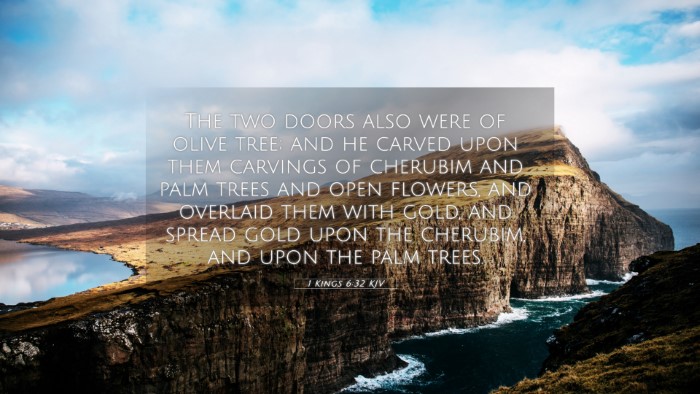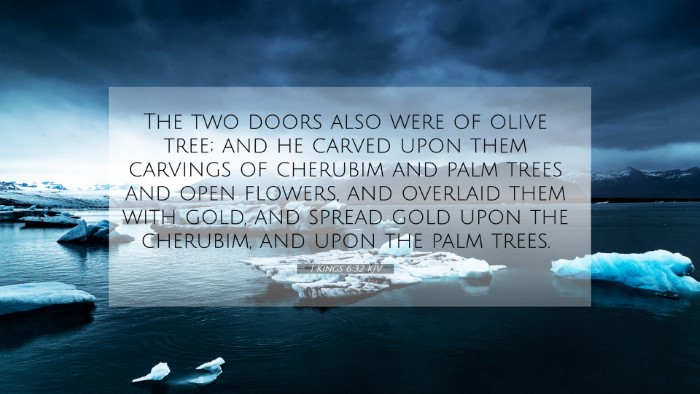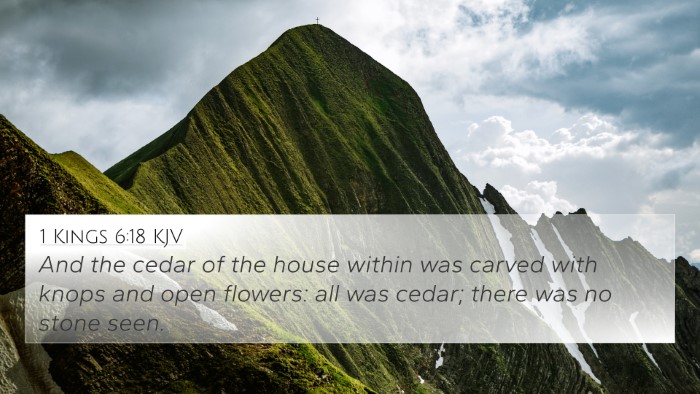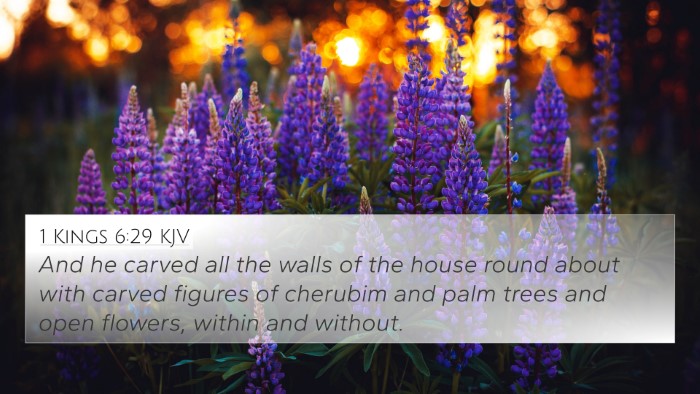Bible Verse Meaning: 1 Kings 6:32
Verse: "The two doors were of olive tree, and he carved upon them carvings of cherubims and palm trees and open flowers, and overlayed them with gold, and spread gold upon the cherubims, and upon the palm trees." (1 Kings 6:32)
Summary of Insights
This verse describes the magnificent craftsmanship of the doors of the inner sanctuary in Solomon's temple. The choice of olive wood, the detailed carvings of cherubim, palm trees, and flowers, and the gold overlay all underline the glory of God and the beauty of the temple.
Commentary Insights
-
Matthew Henry:
Henry elaborates on the significance of the materials used, showcasing the sacred nature of the temple. The olive tree represents peace and prosperity, reflective of the presence of God among His people.
-
Albert Barnes:
Barnes emphasizes the imagery created by the carvings, noting that cherubim represent divine guardianship. The palm trees signify victory and triumph, reflecting the spiritual message behind the temple's architecture.
-
Adam Clarke:
Clarke discusses the symbolism of the gold overlay, indicating purity and divinity. The ornate carvings express the wealth and artistry of Israel during Solomon's reign, which illustrates how worship should be honored through our best efforts.
Thematic Connections
This verse connects to several themes in the Bible, particularly concerning the worship of God and the importance of high-quality offerings. The themes of beauty, artistry, and the presence of God in the midst of His people are prominent throughout Scripture.
Cross-References
- Exodus 25:18-22 - The instructions for making cherubim for the mercy seat.
- 1 Chronicles 28:12 - David's plans for the temple, emphasizing its beauty.
- Isaiah 60:13 - The glory of God reflected in the temple construction.
- Revelation 21:21 - The streets of the New Jerusalem paved with gold, reminiscent of the temple's gold overlay.
- Ezekiel 41:18 - Similar descriptions of the symbolic carvings in the temple.
- Psalms 27:4 - The desire to dwell in the house of the Lord highlights the importance of God's dwelling place.
- Matthew 6:29 - Comparisons to the lilies of the field, indicating divine artistry in creation, paralleling the temple's beauty.
- Hebrews 9:5 - The reference to cherubim in the tabernacle and their significance in the Holy Place.
- 2 Chronicles 3:10-13 - Descriptions of the temple's inner sanctuary and the grandeur of its design.
- 1 Timothy 3:15 - The church as the pillar of truth, drawing parallels to the temple's design and purpose.
Understanding the Construction of the Temple
The construction of Solomon's temple is not only an architectural feat but also serves as a profound spiritual metaphor. Each aspect from the materials chosen to the symbols represented in the carvings provides a deeper understanding of God's relationship with Israel.
The Role of Cross-Referencing in Biblical Study
Cross-referencing Biblical texts allows us to glean deeper insights into verses like 1 Kings 6:32. By identifying connections and thematic overlaps with other scriptures, one can better grasp the overarching narrative and purpose of God's word.
Tools for Bible Cross-Referencing
- Bible concordance - A useful tool to find specific words and themes across the scriptures.
- Bible cross-reference guide - Provides insights into related passages for deeper study.
- Cross-reference Bible study - Techniques to study connections between verses effectively.
- Bible reference resources - Comprehensive materials to help in studying and understanding biblical texts.
Conclusion
1 Kings 6:32 illustrates not only the magnificent craftsmanship involved in the temple's construction but also the deep spiritual truths and artistic expressions that reflect God's beauty and presence. Through careful study and cross-referencing of related scriptures, we can uncover layers of meaning that enhance our understanding of biblical themes and encourage a closer relationship with the Divine.




